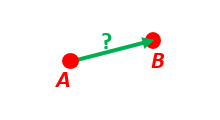5.1.8. nvector.objects.FrameN¶
- class FrameN(point)[source]¶
North-East-Down frame
- Parameters
- point: ECEFvector, GeoPoint or Nvector object
position of the vehicle (B) which also defines the origin of the local frame N. The origin is directly beneath or above the vehicle (B), at Earth’s surface (surface of ellipsoid model).
Notes
The Cartesian frame is local and oriented North-East-Down, i.e., the x-axis points towards north, the y-axis points towards east (both are horizontal), and the z-axis is pointing down.
When moving relative to the Earth, the frame rotates about its z-axis to allow the x-axis to always point towards north. When getting close to the poles this rotation rate will increase, being infinite at the poles. The poles are thus singularities and the direction of the x- and y-axes are not defined here. Hence, this coordinate frame is NOT SUITABLE for general calculations.
Examples
Example 1: “A and B to delta”

Given two positions, A and B as latitudes, longitudes and depths relative to Earth, E.
Find the exact vector between the two positions, given in meters north, east, and down, and find the direction (azimuth) to B, relative to north. Assume WGS-84 ellipsoid. The given depths are from the ellipsoid surface. Use position A to define north, east, and down directions. (Due to the curvature of Earth and different directions to the North Pole, the north, east, and down directions will change (relative to Earth) for different places. Position A must be outside the poles for the north and east directions to be defined.)
- Solution:
>>> import numpy as np >>> import nvector as nv >>> wgs84 = nv.FrameE(name='WGS84') >>> pointA = wgs84.GeoPoint(latitude=1, longitude=2, z=3, degrees=True) >>> pointB = wgs84.GeoPoint(latitude=4, longitude=5, z=6, degrees=True)
- Step1: Find p_AB_N (delta decomposed in N).
>>> p_AB_N = pointA.delta_to(pointB) >>> x, y, z = p_AB_N.pvector.ravel() >>> 'Ex1: delta north, east, down = {0:8.2f}, {1:8.2f}, {2:8.2f}'.format(x, y, z) 'Ex1: delta north, east, down = 331730.23, 332997.87, 17404.27'
- Step2: Also find the direction (azimuth) to B, relative to north:
>>> 'azimuth = {0:4.2f} deg'.format(p_AB_N.azimuth_deg) 'azimuth = 45.11 deg' >>> 'elevation = {0:4.2f} deg'.format(p_AB_N.elevation_deg) 'elevation = 2.12 deg' >>> 'distance = {0:4.2f} m'.format(p_AB_N.length) 'distance = 470356.72 m'
Methods
Pvector(pvector)Returns Pvector relative to the local frame.
__init__(point)Initialize self.
Attributes
R_ENRotation matrix to go between E and N frame